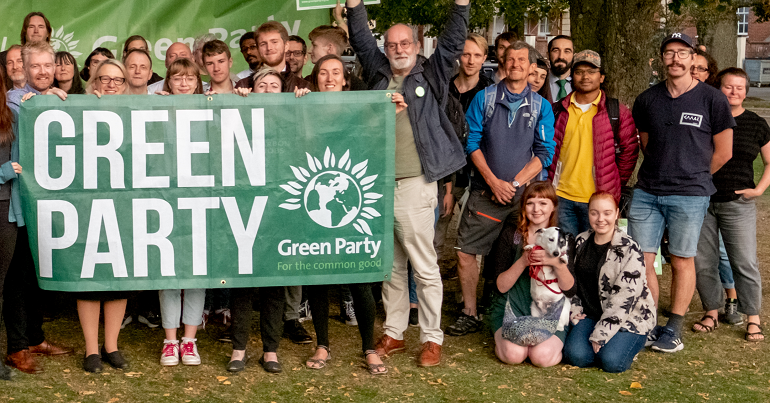5 challenges facing the Green Party of England and Wales in 2021

This article was first published in Left Foot Forward.
With the world being preoccupied by a certain virus in 2020, the normal political cycle and culture was thrown out. Assuming elections aren’t postponed yet again, 2021 will see some return to political normality.
For the Green Party of England and Wales, a number of conditions are coalescing which suggest that 2021 could be a year of historic electoral success. Keir Starmer’s leadership is pulling the Labour Party to the right and the polarising prism of Brexit is no longer distorting the behaviour of voters or political parties. That means there is much more space on the left for the Greens to occupy. Opinion polls have already shown a small shift in the Greens’ direction, with them more or less consistently putting the Greens on between 4 and 5 per cent of the vote since July.
On the other hand, 2021 also presents a series of serious challenges for the party. They are numerous and varied and combined could throw the party off course. Here are the five biggest ones lurking round the corner:
-
Managing expectations
The last set of local elections took place in May 2019. That year, the Greens were the beneficiaries of two unrelated but complementary phenomena.
First, the party was buoyed by the re-energised climate movement of that spring. In February, 15,000 school children participated in one of the first mass mobilisations of the school strike movement in the UK that would continue and grow throughout the year. April saw Extinction Rebellion engage in widespread civil disobedience across London. Combined, they ramped climate change up the political agenda.
Concurrently, polarisation of Brexit caused the electorate to splinter. Left leaning remainers began to desert the Labour Party, frustrated by its triangulation – real or imagined.
With climate in the public consciousness and Labour haemorrhaging remain voters, the Greens had their best ever local election results, doubling their number of councillors overnight.
Similar conditions don’t exist in 2021. With an unprecedented volume of elections taking place next year, maintaining the momentum from 2019 looks increasingly difficult. A repeat performance would signal the Greens’ proper coming of age. Something more diminutive and it will be easy to perceive last year’s success as an aberration, rather than a new norm.
-
Building a new campaign approach
Climate consciousness and Brexit are important explanatory factors for the 2019 ‘Green wave’. But they tell only part of the story. Past Green success in local elections has been predicated on hyper localised campaigning with the party’s slender resources – both financial and volunteer – being heavily targeted in individual wards. The Green campaign approach isn’t especially innovative, but it has been effective – knocking on doors and intensive leaflet delivery has pushed the idea of the Green Party as a viable option at a local level.
The party’s ability to deliver this is obviously diminished by the pandemic. If restrictions continue into the spring – particularly the more draconian of the upper tiers – mobilising significant numbers of activists is increasingly difficult. Developing an alternative approach – one which harnesses social media and technology effectively – will be central to delivering a winning Green campaign in 2021.
-
Cutting through in a narrower media landscape
Another ramification of the pandemic has been the squeezing of air time and column inches for normal politics. The usual routine of the news cycle and political debate has been all but replaced by blanket coverage of the c-word. Where once a Lib Dem or Green spokesperson would sit on Question Time, you now find an epidemiologist. Newspaper comment sections are now taken up by debates on the impacts of the virus, rather than by what’s going on in the rest of politics and society.
With the Greens’ traditional campaigning methods potentially out of the window, making use of the more limited media opportunities may prove integral to the Greens’ prospects next year. That means honing messaging as tightly as possible. It means making every broadcast opportunity count. And it means working with and strengthening the growing alternative and new media outlets that can offer space that the mainstream won’t.
-
Breaking through in the Welsh Parliament
The Green Party’s name suggests it is a force across two of the UK’s nations – both England and Wales. But the reality is that for some time it has largely been a party of England. At the last Welsh local elections, just one Green was elected. The party’s membership in Wales is small. The Senedd remains the only national or regional body in the UK elected under a proportional system without Green representation.
2021 presents an opportunity to change that. It is also an opportunity that will be incredibly difficult to take in the exceptionally crowded field of Welsh politics. The Greens polled seventh in the 2016 Senedd elections, and huge swings are required to flip a seat on a regional list.
-
Moving forward in London
The most high profile election in England next year will take place in the capital as Londoners will vote to elect a new Mayor and Assembly. The Greens have increased their vote share in every election since the Mayoralty was created, and have never dropped below holding two seats on the Assembly.
London’s Mayoral and Assembly election has significance outside of the M25 because the media treats it with greater importance than elections outside the capital. So performing well there is key to building a narrative in the press that the Greens are a real and viable political force.
Capitalising on that has previously proved challenging for the Greens. The party’s growth has been incremental and – despite coming third in the last two contests – the Greens are yet to pose a real threat to Labour or the Tories. On the face of it, there’s reason to believe 2021 will be as previous years have been in that regard.
However, recent polling puts party co-leader Sian Berry hovering around the 10 per cent mark – a result which if borne out in reality would see the Greens double their record performance from 2016. Combining that with the fact that the party has a talented and effective team of both candidates and staff in place means 2021 could be the year the Greens utilise the momentum building opportunities presented by the election and also increase their representation on the Assembly.
PS. We hope you enjoyed this article. Bright Green has got big plans for the future to publish many more articles like this. You can help make that happen. Please donate to Bright Green now.
Image credit: Bristol Green Party – Creative Commons



challenges for the Green Party you missed. 1, how to manage continued splits between people who want to continue to try and form alliances with other parties and people who believe in the Green party. how to stop these splits hindering the Greens growth in local goverment… on which future parliamentary challenges would have to be based. 2, How to get members more involved in decision making rather than just the clique at that the top that is so powerful they can even rewrite the consituition. 3, how to actually come to compromise between trans activists and feminists that respects and cares for the rights of both. 4, how to acheive anything at council level in a world of austerity and bad planning law, 5, learning to give up on the failed battle over brexit and to move forward with our environmental agenda
This is devoid of policy.
Why should people vote Green, voters will ask?
Should we think it is obvious?
And then: what are you offering us? Obvious? No. Everyone’s green now.